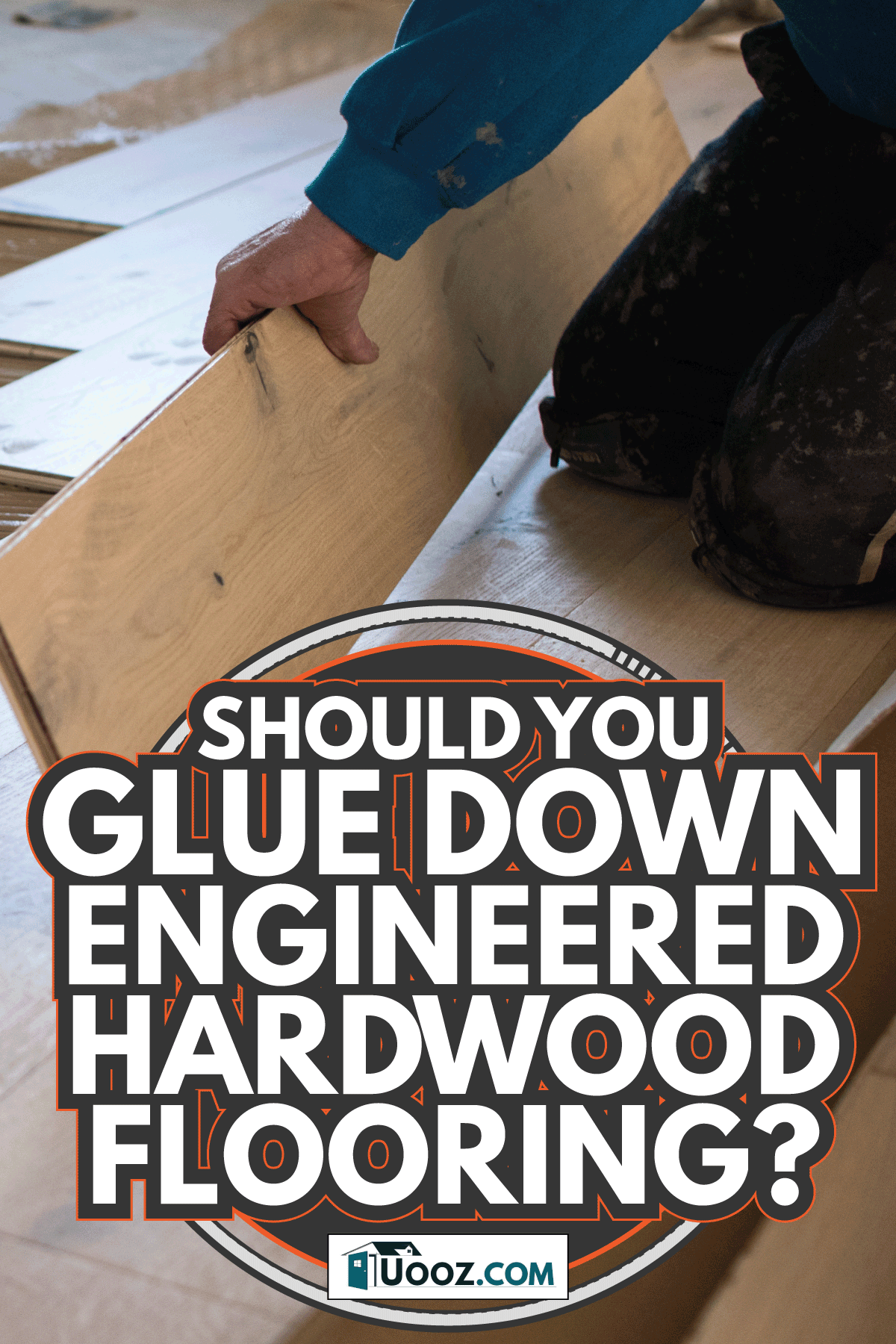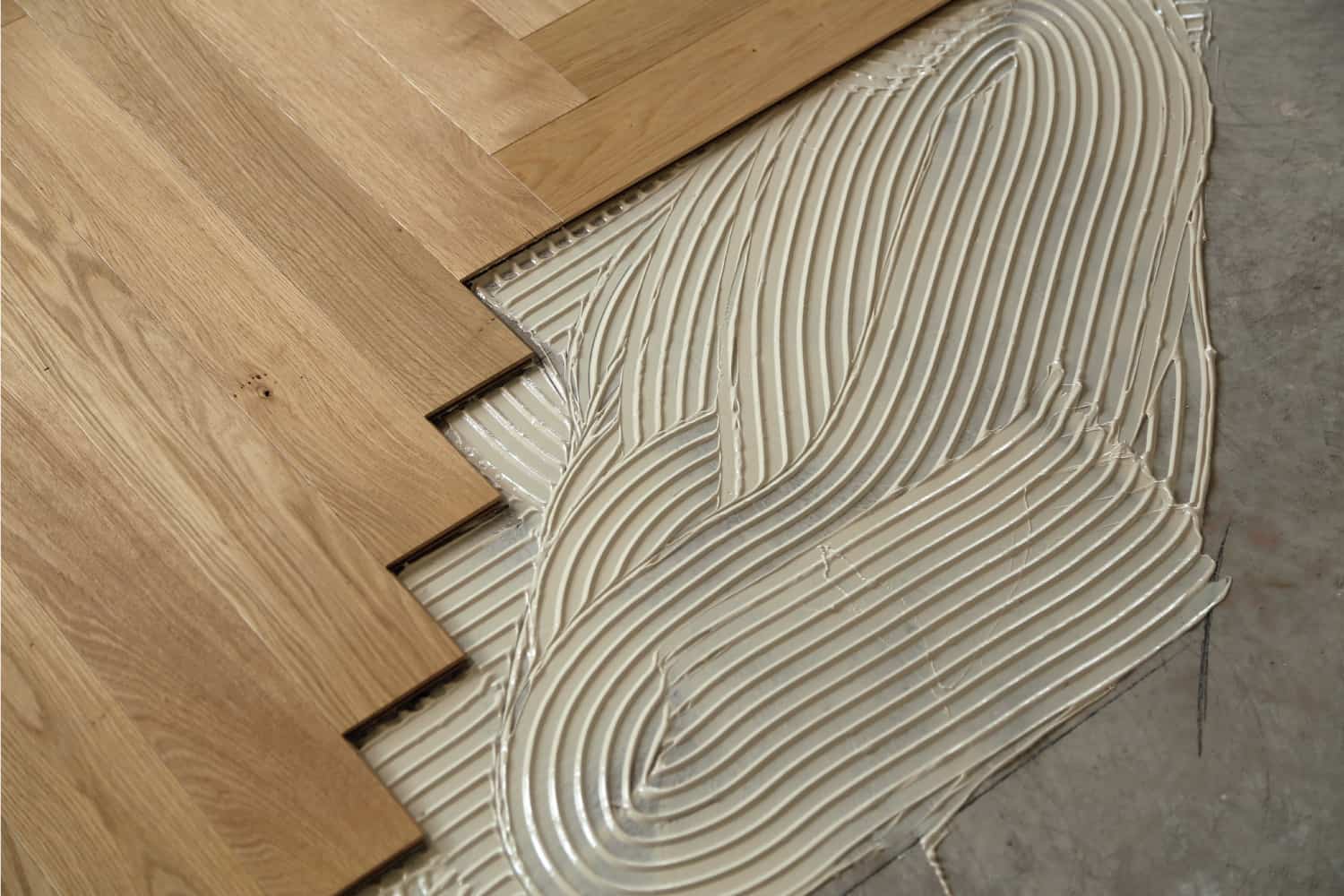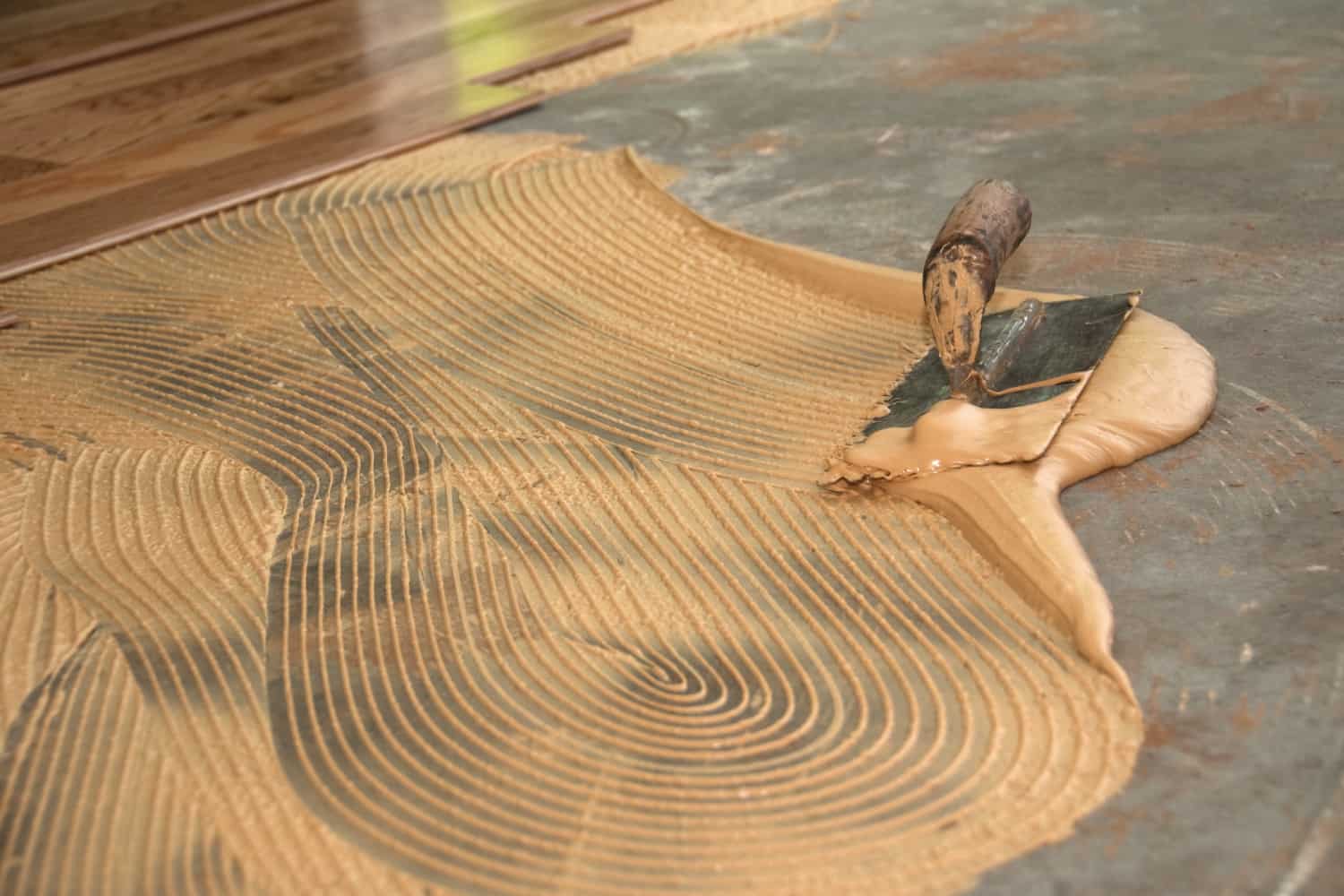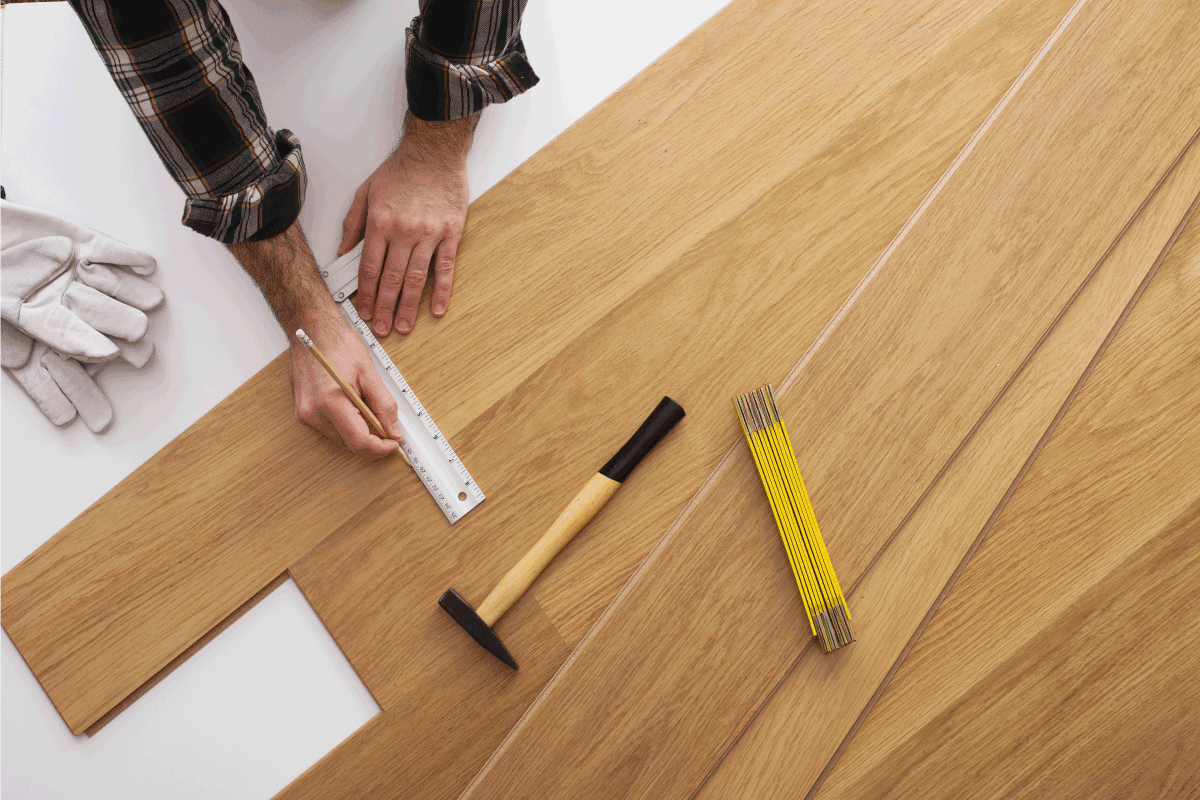Engineered hardwood flooring is a less expensive alternative to solid hardwood, and it is easier to either install or replace. So, you may be wondering if you should glue down your brand new engineered hardwood flooring. You may be leaning towards glue or nails because they are commonly used for solid hardwood floors. But we have thoroughly researched whether or not you should glue down an engineered hardwood floor.
Using glue to secure your engineered hardwood floor to the subfloor will create a stable foundation, but is not always necessary. Unlike solid hardwood, engineered wood floors can also be floated or laid atop a subfloor using an interlocking tongue and groove system. This easy method of installation is often one of the biggest draws for engineered hardwood.
You will have to choose between the stability and challenges of glue or the convenience of floating based on your own personal preferences, budget, and skills.
Installing a new floor can be very time-consuming, so it is important to select the installation method that is best for you. Keep reading to learn about the advantages and disadvantages of gluing and floating your engineered wood floor, the ideal glue or underlayment, and how to remove any existing engineered wood flooring that was glued down already.

Is it hard to install engineered hardwood floors?
The method of installation and your personal home improvement skills will affect the difficulty of the process. However, engineered hardwood is always considered much easier to install compared to actual solid hardwood.
Engineered hardwood floors only have a veneer of solid wood, usually bonded with a core of simple plywood. This means your engineered wood will be much lighter, and therefore much easier to handle.
Also, it won’t need to be nailed down to the subfloor, which is the foundation underneath the surface flooring. Solid hardwood is often nailed into wooden subfloors because it’s less expensive and results in a high level of stability. But this can require serious skills and challenging tools, such as using a flooring nailer to drill numerous holes.

Is it better to glue or float an engineered wood floor?
There are advantages to either installation method, which you will have to weigh against your own personal preferences. You will mainly need to consider how easy it is to install or replace floating floors against the stability of glue.
Float
A floating floor means that the boards have been interlocked using a signature tongue and groove system. Attaching the pieces is considered very easy, resulting in a quick installation that does not require professionals.
These pieces are also very easy to replace. It is usually easier to damage engineered hardwood than solid hardwood, especially in areas with heavy foot traffic. But it is generally more ideal to replace engineered wood rather than repair it.
Not all engineered planks have a veneer that will allow you to simply refinish the surface. Also, since the flooring does not need to be secured directly to the subfloor, it functions well on top of any material. You can read the post "Can You Glue Down A Floating Floor?" for more details on the benefits of a floating floor.
However, it’s important to consider that floating floors are rarely as stable as glued-down, engineered wood. Over time, floating floors commonly have issues with squeaking and slightly giving with each step. In order to prevent this, you may have to purchase an expensive underlay.
Also, you will need some kind of underlay for any floating floor. There is too much room between the subfloor and the engineered wood. You need some kind of support, as well as a defense against moisture.
Do you need a moisture barrier under engineered hardwood?
While many solid and engineered wood floors have surface protection against water, moisture can still rise from beneath and cause serious damage. It can result in warping, popped nails, and even mold.
Mold is a fungus that breeds in moist areas and may cause health issues. The New York state department of health warns that mold can cause difficulty in breathing. You can read the post "How To Install A Vapor Barrier On A Concrete Floor" for detailed instructions on how to add vapor barriers.
What is the best underlayment for engineered hardwood floors?
There are a few different types of materials used for underlayment, which is an essential barrier for moisture, sound, and temperature. You will have to determine the ideal underlayment based on the purpose of the room.
Foam is the most popular underlayment material because it’s relatively inexpensive and still effective at reducing sound. However, areas with a lot of foot traffic may require a cork underlayment.
Cork offers more durability, moisture resistance and may sometimes be applied to straighten out uneven areas. It is also considered to be the most eco-friendly underlayment option.
Click here to find this underlayment for engineered wood on Amazon.
A polyethylene underlayment may be more useful in areas that are more difficult to work around. That’s because it is flexible and easy to handle. It will also provide some of the best sound insulation possible.

Glue
Use glue primarily on concrete subfloors, which would not work with nails. You would need to use a trowel in order to spread an appropriate adhesive on the subfloor. The engineered wood is then directly attached to the subfloor in organized sections.
The amount of glue necessary for the job can quickly increase, and the proper adhesives can be very pricey. Also, it can be difficult to break down this adhesive if the flooring needs to be replaced any time in the future.
However, using glue will also create more stability in your engineered wood. The flooring feels smoother to walk on, and there is less chance of having squeaks in the future. This means that gluing your engineered hardwood floor is the best way to make it feel much more like genuine solid hardwood.
Additionally, the adhesive will often be able to double as a barrier for moisture. You won’t have to worry about purchasing more underlayment, which can be costly too. Also, an underlay will always lift the floor a little higher, which can sometimes result in uneven areas between rooms.
What is the best glue for engineered wood flooring?
There are three primary qualities that you should consider when selecting your flooring adhesive. Firstly, you need to determine the nature of the subfloor. For example, floor adhesives that are better suited for concrete may be too strong for wood subfloors.
Secondly, you will have to determine the drying time of the adhesive. If you are relatively new to the flooring process, then you will likely have trouble installing the floor in time. Then, the adhesive would need to be removed, and you'd have to prepare the surface again.
And the ability to easily clean up your adhesive is the last major priority. If you have trouble installing the floor, you should be able to clean up the glue with ease. Should you decide to replace the flooring at any point in the future, you don’t want the removal process to be troublesome.
As such, it may be best to avoid urethane adhesives. These are incredibly strong, but also difficult to remove. Also, urethane tends to dry quickly. But acrylic adhesives aren’t always the best alternative because they can be susceptible to moisture.
Modified silicone polymers, also known as MS+ are ideal adhesives.
Click here to see this engineered wood floor adhesive on Amazon.
How do you remove engineered wood flooring that is glued down?
This process requires a lot of time and effort, but it doesn’t involve challenging tools or professional skills. First, you will need to remove the floorboards. This is simply done using a pry bar and a hammer.
Click here to see this pry bar on Amazon.
Use the hammer to tap your pry bar underneath one of the boards. Continue down the length of that first board, and make sure the board remains whole. If the board breaks into pieces, each sliver will have to be removed individually afterward. That would require either a chisel or a floor scraper.
Click here to find this floor scraper on Amazon.
Once you have removed the boards one by one and chipped away any split remains, you need to break down the floor adhesive underneath. If there isn’t much, you might be able to use an oscillating tool to scrape the adhesive away.
However, the easiest and most popular method is to apply a commercially sold adhesive remover. The formula is typically poured onto sections of the room and allowed to soak. Then, a simple floor scraper will be able to effectively remove the adhesive.
Click here to see this floor adhesive remover on Amazon.

Summary
Glued and floating floors both have an equal share of benefits and disadvantages. Ultimately, the ideal method of installation will serve your personal needs. So, it’s important to understand what each approach will demand, and what situations each is ideal for.
It should now be clear what tools, products, and skills you will need for glued or floating floors. While using an adhesive will result in more durability, floated floors will generally be easier and cheaper to install.





